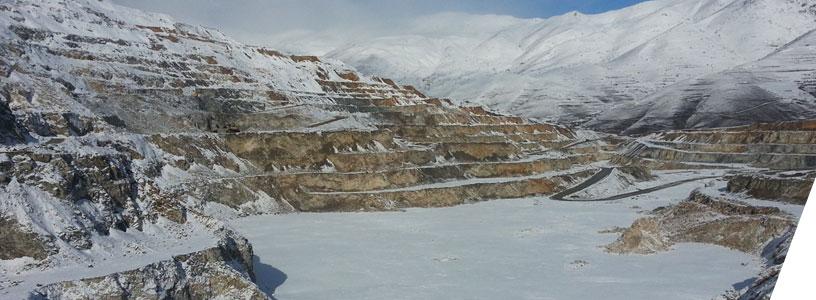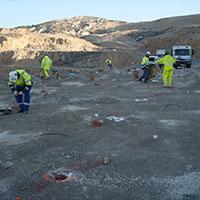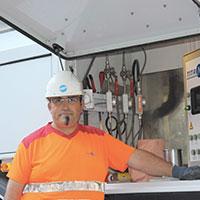
Titanobel is a leader in this sector
Large rock quarries produce essential materials for the construction sector (building and public works). Located in the vicinity of the worksites where their materials are needed, they process the rock from blasting to crushing of aggregates through to selling the finished product. They have to adapt to various local geological and environmental constraints whilst at the same time producing materials that fulfill specialized, demanding quality criteria.
Titanobel, the French leader for explosives distribution and application, supports its quarry customers by optimizing the whole rock extraction process. With its major network of national and international establishments in the vicinity of its customers, Titanobel offers a rapid response and high-quality service. Our mining expertise means that quarry operators are provided with the very best customized technical and financial solutions adapted to each site’s geology and environment.
 On-site charge supportA first-hand account: beneficial expertise
On-site charge supportA first-hand account: beneficial expertise
Vincent is a technical and sales engineer in Southern France. He is attentive to the expectations of the customers and supports them on a daily basis to optimize their mining process by providing them with the benefit of his expertise and knowledge of the quarrying sector.
Vincent, how are the optimization processes established with your customers?
Titanobel intervenes at the request of operators to optimize the extraction aspect of production in their quarries. This optimization involves:
- A site analysis of what is done in order to identify the issues and the various avenues for improvement that can be implemented,
- Setting up specific customized tools adapted to these issues,
- Developing the mining detonation parameters,
- Tests using instruments, with measurement of the results,
- An assessment of development and monitoring of the gains provided by the optimization.
 Blast areaCan you provide us with a concrete example of where you intervened?
Blast areaCan you provide us with a concrete example of where you intervened?
As an example, we intervened at a quarry producing 1 million tons of aggregates a year, concentrating on the following points:
- A good outcome from mine blasting in order to avoid reprocessing the base of blast areas,
- The performance of the blocks to the level indicated in the operating plan,
- The volume blasted per blast,
- The fragmentation of the materials along with a check on the unusable fines rate.
What were the results of this partnership?
Following this assessment, and as a result of the tools and developments implemented, the quarry operator achieved a major financial gain in terms of its “Extraction” budget by improving the operating conditions for his deposit whilst at the same time maintaining tight control of site safety.
The customer continues to monitor what we have implemented, which enables him to see very quickly whether he is faced with a deterioration in his mining process.
 A customer’s siteFirst-hand account: A customer satisfied with the partnership
A customer’s siteFirst-hand account: A customer satisfied with the partnership
This group of 6 quarries (featuring igneous rock) produces around 4 million tons of aggregates every year.
When we arrived at the sites, what we observed was quite straightforward: at nearly all of the quarries there were:
- Too many rocks, which meant the hydraulic rock breaker costs were too high,
- The blocks and the faces were not clean,
- The flow rate for our primary crushers was too irregular.
TITANOBEL nous a proposé avant toute modification du produit explosif fourni de faire un état des lieux fondé sur deux points :
Before making any changes to the explosive product supplied, Titanobel proposed to us that a site analysis should be carried out based on two points:
1. A systematic check of the firing geometry: test bench, spacing, laser readings and drilling checks over several months,
2. A summary covering all of the firings over the last year (based on our firing reports) for each of our sites in order to have a working database and details for comparative purposes for the changes to come. (mass of the explosive used, the cost of the explosive per blast, the cost of the broken rock cleared per ton, etc.)
Regarding point 1, we realized that we routinely blasted out 15 to 20% more materials than in theory.
On realizing this, with Titanobel’s help we systematically laid out drill holes with a 2D laser at all of our sites.
The database for point 2 enabled us to set up a centralized system at group level to monitor consumption levels and the costs per ton blasted per quarry and per firing. We were thus able to carry out real-time monitoring of the impact of any change in parameter for our blasting operations at each of our sites.
Once all the bases were correctly adjusted, we worked on the explosive products. Titanobel proposed a solution to us for manufacturing explosives directly on site, which enabled us to free ourselves of the impact of water being present in the holes.
The outcome of this approach has been very positive for us.
We did not significantly reduce our explosive consumption, but the explosive energy is now more judiciously used:
- We have reduced our annual hydraulic rock crusher bill by at least half,
- The extraction conditions at the rock face have been substantially improved: better yields from charges, less sorting, block regularity, etc.
- With better fragmentation, we have optimized the flow rates for our primary crushers.
 A UMFE operatorFirst-hand account: Employees trained in customer service
A UMFE operatorFirst-hand account: Employees trained in customer service
Maximim has been working for Titanobel for 16 years. Having worked initially as a driver/miner, he gradually became an operator working on a UMFE (Mobile Explosives Manufacturing Unit) in Western France.
What has been your career path with Titanobel?
I started in 1999 as a blaster’s assistant, then I got my CPT (Blasting Officer’s Certificate), and obtained my heavy and super heavy vehicle driver’s license; I was only doing detonations using traditional explosives; we had only just begun on-site manufacturing (there was only one UMFE).
Concerning the manufacture of explosives on-site, as I had a super heavy vehicle license, initially I handled getting the truck around the quarry and then I asked if it was possible to be trained as an operator.
 Maximim at the control stationDuring the ten years when on-site manufacturing has been carried out, have there been any major changes?
Maximim at the control stationDuring the ten years when on-site manufacturing has been carried out, have there been any major changes?
It is true that when you think about it, it has been a long trip. We initially worked with an emulsion based on ammonium nitrate and heating oil. Product sensitization was carried out by adding glass microspheres.
Nowadays, heating oil has been replaced by a type of oil that involves less odor, the injection diameter of the pipe had been substantially reduced, and product sensitization is carried out using chemical gassing. The trucks have also been simplified in terms of how they function. So we lay charges for larger blasts in less time than before, and more easily. Also, the UMFE operator always has to be independent and capable of dealing with the unforeseen when he is manufacturing at a quarry.
This new explosive also offers higher performance, so the results of the blasts (fragmentation) are better for the customer.
Safety has developed; in terms of explosives, we have always had strict rules, while the changes made at quarries over the last few years have been spectacular.
In your opinion, what are Titanobel’s advantages?
We spend a lot of time on training, which enables Titanobel to have a well-trained operational workforce. We benefit from all the feedback within the company.
The quality of the products and our responsiveness are Titanobel’s key strengths in the Western region.








